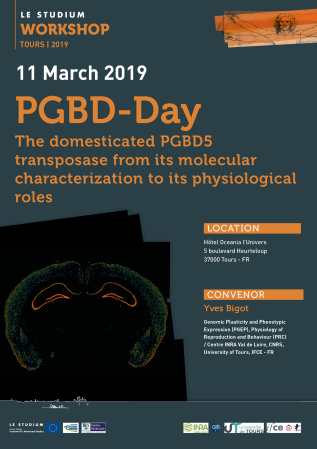PGBD-Day
The domesticated PGBD5 transposase from its molecular characterization to its physiological roles
Hôtel Oceania l’Univers
5 boulevard Heurteloup
37000 Tours
France
Presentation
Transposable elements (TEs) are mobile repetitive genetic elements found in all investigated genomes. Beside the mutagenic impact of TE mobility in host genomes, genes derived from transposase (Tpase)-coding DNA transposons have repeatedly been exapted by host genomes. However, domestication of fully active Tpases (able to perform DNA binding, cleavage and strand transfer) is a rare event. It has occurred over time in spite of the potentially high nucleasic toxicity of Tpases, suggesting a high value of such domestications to the host. In humans, at least 3 of 54 domesticated Tpases (RAG1, THAP9 and PGBD5) are still active, with evidence that RAG1 is involved in programmed genome rearrangements. In the ciliate Paramecium several domesticated piggybac-derived Tpases (PGBD) cooperate in programmed DNA elimination processes, during which tens of thousands of gene-interrupting germline sequences are massively excised to reconstitute functional genes in the somatic nucleus. Vertebrate PGBDs (1 through 5) display features reminiscent of the ciliate recombination machinery. In this context the expression profile of PGBD5 suggests it might be the key active Tpase of a mechanism mediating DNA rearrangements in neurons and necessary for accurate brain functioning.
Speakers
- Mireille Bétermier, Institute for Integrative Biology of the Cell (I2BC) - FR
- Yves Bigot, Physiology of Reproduction and Behaviour (PRC) - FR
- Laura Helou, Physiology of Reproduction and Behaviour (PRC) - FR
- Alex Kentsis, Memorial Sloan Kettering Cancer Center - US
- Pierre Pontarotti, Mathematics Institute of Marseille - FR
- Eric Reiter, Physiology of Reproduction and Behaviour (PRC) - FR
- Sébastien Tempel, Bacterial Chemistry Laboratory - FR
Programme
- 09:00 Welcome to the Hôtel l’Univers
Session 1: TE domestication
- 09:15 Pierre Pontarotti - Concepts and approaches to study TE exaptations
- 09:45 Mireille Bétermier - PGBDs in cilliates (Role, functioning and mechanism complexity)
- 10:15 Laura Helou - Novelties about the evolution of PGBDs in vertebrates
- 10:30 Coffee break
Session 2: PGBDs as key actors of the genome biology
- 11:00 Alex Kentsis - A synthesis about the biology of PGBD5 in human
- 11:30 Sébastien Tempel - High throughput strategy to analyse of PGBD5 recombination events in murine CNS
- 12:00 Concluding remarks about the evolutionary convergences between cilliate and vertebrate PGBDs
- 12:15 Lunch
Session 3: Impact of PGBD5 in genetically modified animal models
- 13:20 Alex Kentsis - First results with KO mice for PGBD5 (mainly behaviour and neurobiology)
- 14:00 Yves Bigot - First results with KO animals for PGBD5 in Tours (zebrafish, mice and histology)
- 14:30 LE STUDIUM Loire Valley Institute for Advanced Studies - LE STUDIUM's tools to develop international interactions on emerging scientific project
- 15:00 Coffee break
Session 4: Complex properties of PGBD5
- 15:30 Eric Reiter - Advantages and facilities in Tours around nanobodies directed against difficult targets as PGBD5
- 16:00 Yves Bigot - PGBD5 isoforms among vertebrates (evolution and activities)
- 16:30 Concluding discussion about tools and experiments required to further study PGBD, and future projects
- 17:00 End of the meeting
Partners of the event








